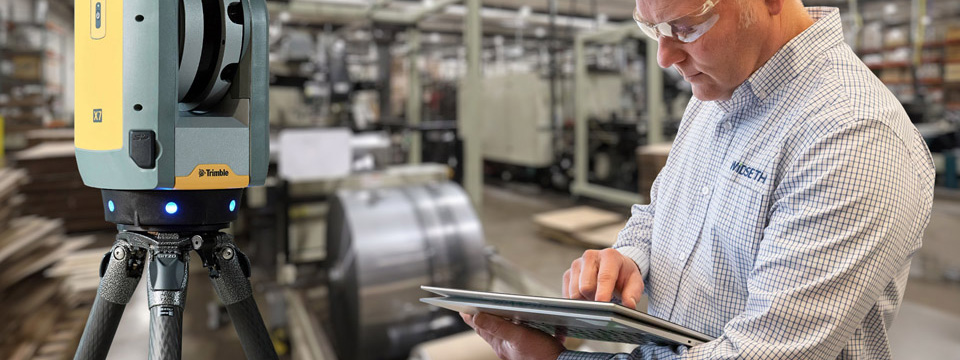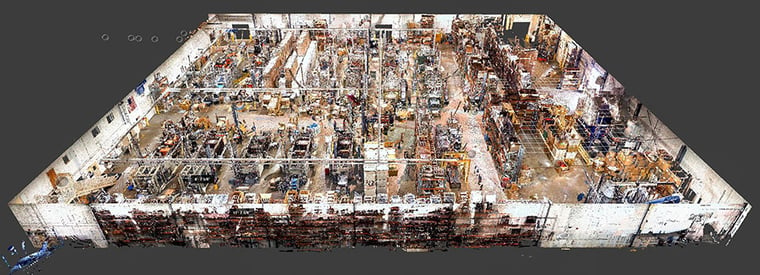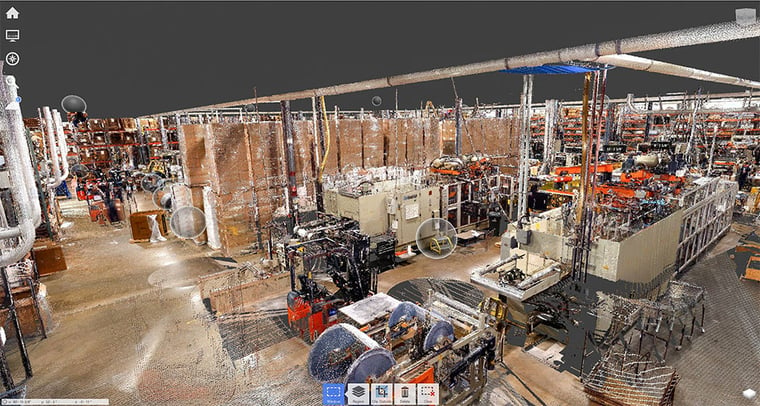This Process Is a Game Changer for How You Manage Your Facility

"Scan-to-BIM" Generates a Wealth of Information to Speed Up Your Planning, Design, or Expansion Efforts
"Scan-to-BIM" is the process of collecting lidar data points and photographs of a physical space or site, which are then used to create 3D models. These digital representations can be used for expansion planning, monitoring construction progress, equipment configuration, or future design and layout decisions. Imagine Google Street View but with millions of data points—true to scale—showing every surface inside the building.
First, some definitions. Lidar stands for light detection and ranging, or laser imaging, detection, and ranging. It is a method for determining the precise location and dimensions of objects or surfaces by pointing a laser at them and measuring the time it takes for the reflected light to return to the scanning device. BIM stands for building information modeling, a process for creating three-dimensional representations of spaces, fixtures, and equipment and associating relevant data with them, such as power requirements or maintenance schedules. The scanner creates a “point cloud”—an array of millions of points that form an image—that is then imported into BIM software to be manipulated.
 Overview of a digital model created from the Scan-to-BIM process.
Overview of a digital model created from the Scan-to-BIM process.
Widseth recently created as-built drawings for a central Minnesota manufacturer. Our client wanted to know exactly where each piece of equipment was located, how big it was, the available power sources, column locations, walls, roof trusses, etc. Traditionally, this would have required two people spending multiple days with a tape measure, laser, ladder, and notebook. Then, someone would have to transfer all that information into a digital drawing or 3D model. Scan-to-BIM takes considerably less time, is more accurate, and allows designers to quickly manipulate vast amounts of data.
We used a Trimble X7 scanner to collect lidar data and still photos of the manufacturing facility. The scanner was set up on a tripod in numerous locations throughout the space to ensure adequate data collection. It is necessary to scan from different vantage points to capture all the surfaces within the space. While the scanner is rotating 360 degrees to generate the point cloud, photos of the space are simultaneously captured. It takes only a few minutes to collect the lidar points and photos in each setup location.
 Each sphere represents a scan location.
Each sphere represents a scan location.
Once the scans are finished, data processing begins. Back at the office, the collected information is downloaded, and the files are opened in AutoDesk Recap Pro. This application registers the point clouds and photos—that is, it knits the individual scans together to form a complete, wall-to-wall picture of the facility. After the data has been registered, Recap Pro generates a 3D model. Highly accurate measurements can be taken from any surface, and various architectural drawings can be produced such as floor plans, elevations, and sections.
Our client will use the drawings and models we produced for long-term space planning as well as to address an immediate need: where to place a new conveyor system. Armed with this information, they will be able to quickly test various machine configurations to understand the most efficient layout. And, they now have highly accurate as-built drawings, which will be invaluable for any future additions or remodels.
Scan-to-BIM offers several advantages prior to and during construction, as well. It’s an efficient way to quickly generate a highly accurate site model to serve as the foundation for design. During construction it’s a great way to track progress and document elements that will be hidden later, such as plumbing, gas, electrical, and data lines.

Search Archives
Categories
Posts by Topic
- Staff News (98)
- Architecture (66)
- Funding (61)
- Civil Engineering (53)
- Education (48)
- Architectural Design (38)
- Engineering (37)
- Land Surveying (32)
- Surveying (26)
- Environmental (22)
- Commercial (21)
- Interior Design (18)
- Streets & Highways (17)
- Utilities (17)
- Water Resources Engineering (14)
- Industrial (13)
- Community (11)
- Cultural (11)
- Landscape Architecture (11)
- Sports & Recreation (11)
- Government (10)
- Aerial Mapping (8)
- Mechanical Engineering (8)
- GIS (7)
- Electrical Engineering (6)
- Structural Engineering (6)
- Senior Living (5)
- Transportation Engineering (5)
- Bridges (3)
- Site Design (3)
- Transmission & Distribution (3)
- Healthcare (2)
- Planning (2)
- manufacturing (1)
Recent Posts
-
May 06, 2024



